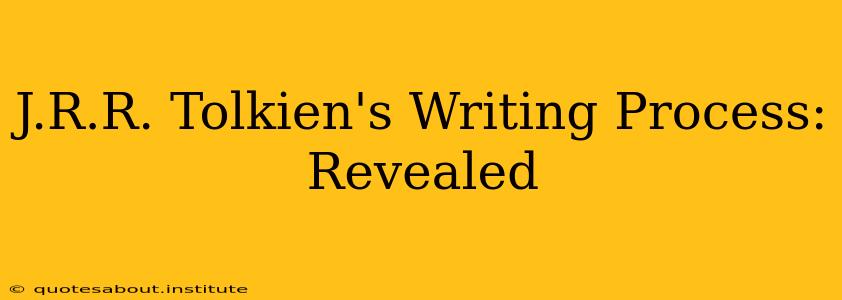J.R.R. Tolkien, the celebrated author of The Hobbit and The Lord of the Rings, captivated readers worldwide with his richly detailed world of Middle-earth. But the meticulous craftsmanship behind his legendary works often remains shrouded in mystery. This exploration delves into Tolkien's unique writing process, revealing the methods and philosophies that shaped his enduring legacy. Understanding his approach offers valuable insights for aspiring writers and illuminates the dedication behind one of literature's greatest achievements.
What Inspired Tolkien's Writing?
Tolkien's creative process wasn't solely driven by grand narratives. Instead, it sprung from a deep fascination with languages, mythology, and history. His early linguistic studies profoundly influenced his world-building, leading him to create intricate languages for his characters, which then informed their cultures and histories. This bottom-up approach, starting with the linguistic foundations and building outward, is a unique aspect of his method. He didn't simply invent a story; he meticulously constructed a living, breathing world.
How Did Tolkien Create Middle-earth?
Tolkien's world-building was legendary, a slow, deliberate process spanning decades. He didn't simply write a story and then add details; he constructed a comprehensive history, geography, and mythology for Middle-earth long before penning The Hobbit. This meticulous approach ensured internal consistency and depth. He kept detailed notes, maps, genealogies, and timelines—a testament to his commitment to creating a believable and immersive world.
What Was Tolkien's Daily Writing Routine?
While there's no single documented daily routine, accounts suggest Tolkien worked in bursts of intense concentration, often in quiet solitude. He preferred to write longhand, meticulously crafting each sentence and paragraph. This deliberate pace allowed him to refine his prose and ensure clarity and precision in his descriptions. The extensive revision process that followed was just as crucial as the initial writing itself.
How Did Tolkien Overcome Writer's Block?
Overcoming writer's block wasn't a simple matter for Tolkien. His approach suggests a focus on deep immersion in the world he was creating. He frequently revisited his notes, maps, and linguistic details, allowing the story to organically develop from the rich foundation he had laid. It wasn't a matter of forcing words onto the page, but of allowing the story to unfold naturally from the already established world.
What Were Tolkien's Key Writing Habits?
Several key habits characterized Tolkien's writing process:
- Meticulous Planning: Tolkien's legendary planning is well-documented. He meticulously outlined his stories, creating detailed histories, genealogies, and maps of Middle-earth before he began writing.
- Detailed World-Building: The depth and complexity of his world-building are unmatched. He created languages, histories, and cultures, bringing a level of realism rarely seen in fantasy literature.
- Longhand Writing: He preferred to write longhand, allowing for a more deliberate and thoughtful approach to his prose.
- Extensive Revision: Tolkien was a meticulous reviser, constantly refining his work to achieve the perfect balance of style and substance.
Did Tolkien Use Outlines?
Yes, Tolkien famously utilized extensive outlines, maps, and timelines to structure his narratives. These weren't simple plot outlines; they were comprehensive historical records of Middle-earth, detailing the lineages of characters, the history of nations, and the evolution of languages. This approach allowed him to maintain consistency and depth throughout his works.
What Software or Tools Did Tolkien Use?
Tolkien predated the widespread use of computers and word processors. He wrote primarily by hand, relying on pen and paper to craft his legendary works. This hands-on approach fostered a deeper connection to his writing, allowing for more nuanced control over his prose.
What Lessons Can We Learn from Tolkien's Writing Process?
Tolkien's writing process offers invaluable lessons for aspiring writers:
- The Importance of World-Building: Creating a rich and believable world is crucial for engaging readers.
- The Value of Planning: Thorough planning can prevent writer's block and ensure a consistent narrative.
- The Power of Revision: Refining your work is essential to achieve clarity and impact.
- The Benefits of a Deliberate Pace: Taking your time and focusing on quality will lead to better results.
J.R.R. Tolkien’s enduring success lies not just in his imaginative storytelling but also in his dedicated and meticulous approach to writing. His process, characterized by deep world-building, meticulous planning, and painstaking revision, serves as an inspiring model for writers who aspire to create works of lasting impact. His legacy is a testament to the power of dedication and a commitment to crafting a truly immersive and believable world.

